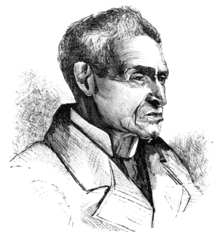Ramón Torres Méndez
Ramón Torres Méndez (29 August 1809 - 16 December 1885) was a Colombian painter and lithographer considered one of the most prolific and important costumbrismo artists of the 19th Century in Colombia,[1][2] best known for his genre works into everyday Colombian life documenting the costumes, occupations, and pastimes of the common people of his time.
Ramón Torres Méndez | |
|---|---|
 Engraving of Ramón Torres Méndez in 1887 | |
| Born | 29 August 1809 Bogotá, D.C., Colombia |
| Died | 16 December 1885 (aged 76) Bogotá, D.C., Colombia |
| Nationality | Neogranadine |
| Known for | Painting |
| Movement | Costumbrismo |
| Spouse(s) | María Coleta Medina Morales (1840-) |
Further reading
- González, Beatriz (1986) [1938]. Ramón Torres Méndez: entre lo pintoresco y la picaresca [Ramon Torres Mendez: Between the Picturesque and Picaresque] (in Spanish) (2nd; illustrated ed.). Bogotá: C. Valencia Editores. ISBN 978-958-9044-21-6. LCCN 87400903. OCLC 16805231.
- Sánchez, Efraín (1987). Ramón Torres Méndez: Pintor de la Nueva Granada, 1809-1885 [Ramón Torres Méndez: Painter of the New Granada, 1809-1885] (in Spanish). Bogotá: Fondo Cultural Cafetero. ISBN 978-958-9144-00-8. LCCN 88192547. OCLC 18398786.
gollark: #6 seems like it doesn't actually work.
gollark: LyricLy is LITERAL muonic lithium.
gollark: Unless you extend the deadline arbitrarily, as you obviously must.
gollark: I forgot to write anything, so I guess this round will be contragollarious.
gollark: You stole my entry!
References
- Pini de Lapidus, Ivonne (2001). Fragmentos de memoria: los artistas latinoamericanos piensan el pasado [Fragments of the Past: Latinamerican Artists Think the Past] (in Spanish). Bogotá: National University of Colombia. p. 27. ISBN 978-958-695-050-3. LCCN 2002417497. OCLC 50722644. Retrieved 2011-11-12.
- Turner, Jane (2000). Encyclopedia of Latin American and Caribbean Art. Grove encyclopedias of the arts of the Americas. New York City: Macmillan Reference USA. p. 199. ISBN 978-0-333-76466-4. OCLC 460716915. Retrieved 2011-11-12.
This article is issued from Wikipedia. The text is licensed under Creative Commons - Attribution - Sharealike. Additional terms may apply for the media files.